Nebraska's elephants
The news article reveals that the famous Field Museum of Natural History in Chicago had dispatched its team to the region of the Niobrara River to search for fossils. "Marshall Field of New York" financed this expedition. Of note were the shovel-tusked elephant from Frontier County, the giant hog from Banner County and literally thousands of "diminutive early camels." It is high irony that Nebraska should be both the deposit for these artifacts on one hand, and the most celebrated opponent of the theory of evolution: William Jennnings Bryan, on the other!
But the eye-opener came in the report of Dr. Barbour's remarkable observation which we quote: "Nebraska has more elephants buried within its boundaries than it has bodies of human beings." Even for 1931 this is quite a claim. We have grown callous to the reports that we have more cattle than people, a fact our eastern friends like to chortle about. It probably follows that the hog or even chicken population rivals that of us humans. But elephants!? I say, let's leave them underground.
-Dalakarl
...................................................
Baptism debate
"Next Wednesday and Thursday evenings there will be a debate on baptism, which has been arranged between the pastor of the Mission Church (Fred Hall) and Rev. Linus Johnson (First Baptist).
On Wednesday evening we meet in the Mission Church and the question for debate will be: 'Resolved that Immersion is the Only New Testament mode of baptism.' Rev. Linus Johnson takes the affirmative and Rev. Fred Hall the negative side.
On Thursday evening the subject: 'Resolved That Children according to the New Testament Are Eligible for Baptism' will be discussed..." (Hall affirmative, Johnson negative)
Have we now returned to the raucous old days of theological wrangling? I think not; more of the spirit of the old Civil War reunions at storied battlefields where gray and stooping veterans shook hands across rail fences, the southerners giving their best gerontological rebel yells, and the G.A.R. boys doing whatever they did in return. The cannons may have been rolled out but they were not loaded. Rev. Johnson's response seems to indicate this:
"The Interpreters are no doubt rallying for the old battle fields as they announce two debates...though...it does not create the best community spirit, (I) still accept the challenge... One challenged in a debate refusing to meet his opponent is always considered the losing party." No report on the outcome was printed, but a footnote can be added from a piece later quoted from the Lindsborg, Kansas, paper that same month:
"Rev. (Linus) Johnson reveals he is soon to receive his Master of Sacred Literature from Wesleyan Theological Seminary (Pittsburg) on May 7." The article goes on to say this is his fifth graduate degree, the others being a B.A. and M.A. from Bethany Lindsborg and B. Th. and B.Div. from Bethel in St. Paul. One wonders if Rev. Hall may have "bitten off more than he could chew" in challenging Johnson?
-Dalakarl
...................................................................
The old library
As background to this story we have to go back to the late 1970's when Gladys Bergreen Woodworth became the first resident to move in to Park Villa. She was one of those rare individuals whose memory extended to before 1920 when the Greenwalls left Polk County for Wausa. She showed me a picture of herself and her country school students which included my uncles Herman and Herbert Greenwall. It was one of those moments that made our Polk county roots come alive.
Now we are at the old library, going through Berneice's extensive collection of school papers which includes some from her student days as well as from her days as a teacher. She even had preserved the construction records of her school, district 36, including the amounts and sources of building materials. A full page listed all former teachers of the school including some familiar names such as Marian Nordlund, Julia Falk, Myrtle Anderson, Mertina Larson and...Gladys Berggren.
It did not dawn on me right away, till getting out the old plat map showing school districts revealed that district 36 was indeed the Durant school. This was the history of my uncles' school. Gladys had even told me that it was my grandfather John Greenwall who as school board chairman had hired her to be the teacher!
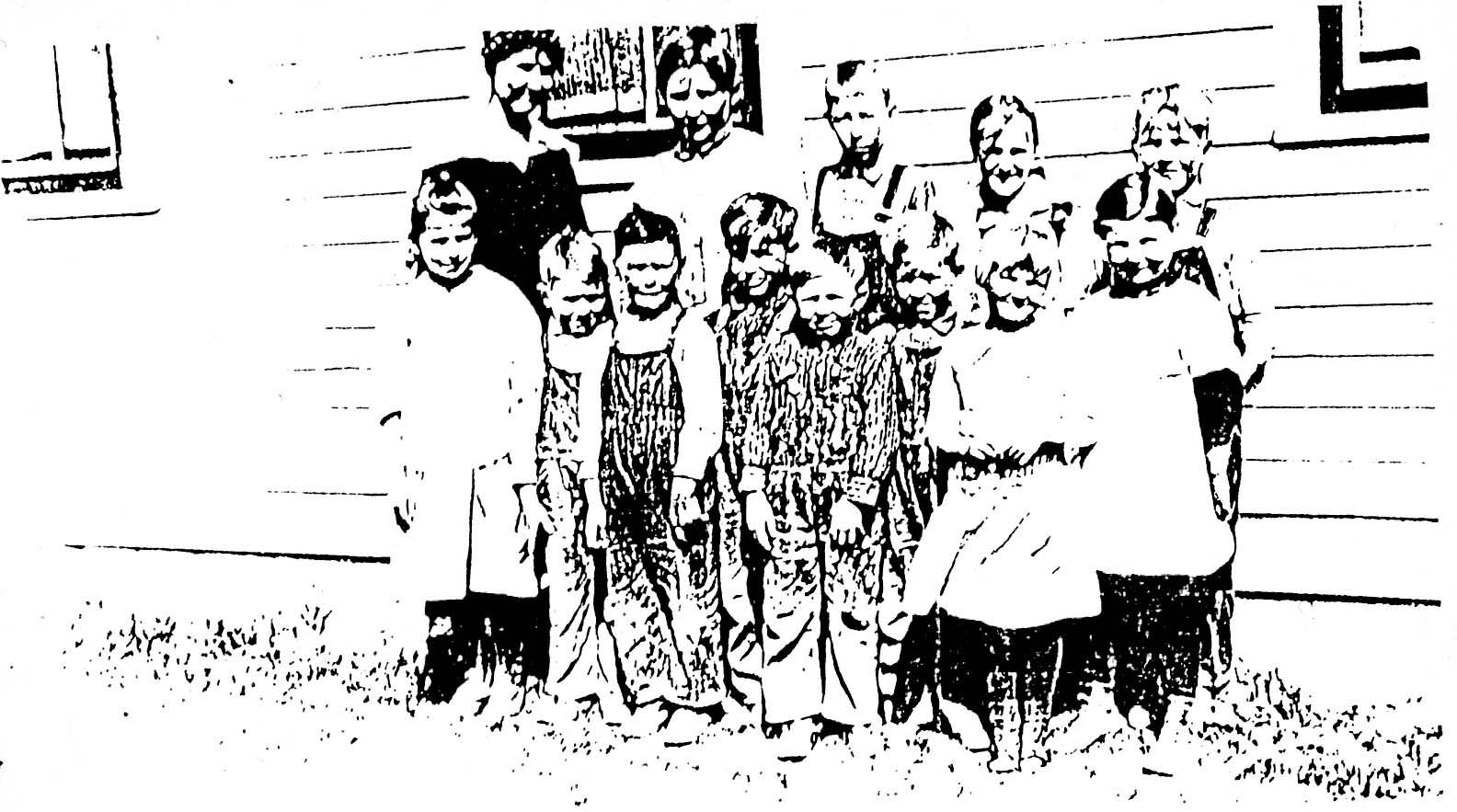
Uncle Herbert, center back row; Herman, second from left, front row
As part of the school's history, a summary of who lived in the district is included. The district's east half was in Stromsburg precinct and the west half in Prairie Home. One of the Prairie Home farms was occupied by Harry Rodene, who was the first cousin of my grandmother. According to Merv Ransom, two of his wife's brothers would have attended that school. Thanks to Merv and to Darwin Carlson for their recollections of district 36.
Another small mystery was also solved. When grandpa moved off the Morrill estate it was said he occupied a house owned by Harper Reed. Real estate records show Reed had a house in town and some property just west of town. But the old plat maps show that he also owned the land occupied by Durant...so grandpa probably moved directly there where he remained till 1920. One of the stories in Berneice's collection states that the first dwelling on that farm was a dugout...another item previously unknown to me.
Now you can see why these discoveries at the old library were exciting to me, and why I'll be going back.
-Dalakarl
.......................................................
Dirt roads and auto cranks
"Someone advertised for a 'lost bearing cap for an automobile with a screw top grease cup attached,' whatever that was, there isn't anything like that on the present day makes of automobiles. It is not so many years ago that the Headlight office was a clearing house for automobile cranks -- someone found a crank on the road and brought it in to the office. Sometimes it happened we would have over a dozen, and we could not keep tab on all, if someone inquired for a lost auto crank we'd just say: 'help yourself'." A wall display of 1907 era cranks would make an interesting conversation piece today, wouldn't it?
In other 1931 auto news we found that the road that once went by "goldenrod road" and "the white way" had recently changed again, from state route 16 to highway 92, which is how we know it today. Also the cemetery road had just been graveled all the way to the Gresham road. When gravel was put down it was always remarked how great an improvement this was. Now a dirt road is specially marked "minimum maintenance" and most are scared to try it.
-Dalakarl
..........................................................
The Sioux language
Well, it was about another one of the displaced native American tribes or groups of tribes that ranged in the area back in the day. The odd spelling can be blamed on the French, back when French fur traders also wandered about the Missouri River valley and gave names to such things. When son John spent time in Germany as an exchange student, he was surprised to find that the Germans, who are very interested in native Americans, pronounced the name "see-ox." They were saying it phonetically. We know it was "Soo-land" not "See-Ox-land!"
Then yesterday at church a friend made a remark that came as a great surprise to me. He said that his father had grown up knowing two languages: English and Sioux! It seems that his family lived among reservation Sioux and their children, who were still speaking their native language, effectively taught their playmates to be bi-lingual! Just across the Platte to our north is Genoa, where the "Indian school" buildings still stand. Their purpose was to instill "American" (really, Western European) ways in native American children who were removed from their families and placed in this school, which they uniformly hated.
What a contrast between these two ways to learn language! Removing children from their homes to be indoctrinated by government employees on the one hand, and natural learning on the playground from other children on the other. Add to this the fact that the playground learning went both ways: the English speakers learned Sioux and the Sioux, English.
Reading and thinking about the immigrant days here in Nebraska, one finds frequent references to those native Americans who still were in the process of being moved to reservations; reservations which were then routinely "opened" for land purchases by our immigrant ancestors and others. The things that are being forgotten about the immigrants are joined by those things being forgotten about the people who lived here before them. We need to remember.
-Dalakarl
.........................................................
Indian words you already know
Once you get past the "New England" states with their reflection of "old England:" New York, New Jersey, New Hampshire, etc., things change. That may have something to do with the war with England which tarnished the image. On the other side of the Appalachians names like "Ohio," "Michigan," "Illinois" and "Arkansas" reflect native American roots. "Indiana" took one step further and embraced the whole race.
But it didn't stop there. "Nebraska" is a Pawnee word meaning "flat water," confirming the Platte valley's dominant feature in our state. "Platte" is French and recalls a time when that nation's fur traders operated here. Louisiana is another indication of French influence, but another war may have put French names in disfavor. The Dakotas, Idaho, Colorado, Kansas and Oklahoma expand the list.
It seems incongruent that the "Indian wars" which were waged by the U.S. government against the native Americans and the relocation of tribes to reservations should be accompanied by this trend to name the states this way. It would be nice to think that this was symbolic of honoring these original occupants of North America, but I'm afraid it was just a fad.
-Dalakarl
.........................................................
Linds
But the name on a gravestone that started a chain of associations was that of "Lind." "Swede" Lind was a friend who took us on guided tours of such Polk county hidden treasures such as Pawnee burial grounds on the bluffs and where to pick decorative bittersweet plants. Swede was also an avid birder and a regular visitor at Covenant Home. We had just seen Norma Lind Rodine at church, another instance of the Lind name.
Lind is one of those Swedish "ornamental" names meaning lime tree. Why lime trees were significant to Sweden may be related to the extensive nautical involvement of the population. Having limes aboard ships was a guard against scurvy which plagued sailors on long voyages. Lind can stand alone as a name as can "Ek," or oak. But it was a great favorite for pairing with other words.
On our home section near Wausa there were just two farm places. The other one was Clarence Lindquist's (lind twig). My dad was Clarence Greenwall; two Clarences across the fence. No one called Lindquist by his real name, however. He was known as "Bub" and was the Justice of the Peace for our township. In the other direction lived Sherm Lindquist (no relation) who was brother to Ival, Frank and Gracie. Frank's son Roger was in my grade and was a car enthusiast friend.
Then there were Lindahls (lind dale or valley), one of them became county attorney at Wahoo. There were Lindstroms (lind stream) including one of our pastors. An aviation fan who was my friend and I hoped he might be related to Charles Lindberg, the famous "Lone Eagle," but that was too much to hope for. Besides, "berg" means mountain.
In college one of my best friends was named Lindskoog (lind woods). Lindgren (lind branch) was the Wausa IH dealer for a time and they were on our telephone party line. Here we should say that "Linder" is another whole subject. It means linden tree and has also been taken as a name in various forms.
I have never heard of the name "Lindlund" although it would be feasible (lind grove.) Maybe too many "L's"...how would you like to be named Lillie Lindlund? Lindlov (lind leaf) has the same problem. Lindvall (lind meadow) has been encountered. Of course, we had just plain "Linds" in Wausa, too. And that brings us back to the place we started and a good place to end.
-Dalakarl
................................................................
Convertible Army Chapels
The subject was the way in which the military provided chapels for its many bases built during that time. They hit upon the idea of standardizing the plans for these chapels including "convertible" altar areas which could be variously screened or expanded to serve Jewish, Protestant and Catholic services. The overall design was very basic, more in the New England Congregational style than anything Gothic. There was a spire, but it was small and not very tall.
The article included drawings and pictures of examples of these chapels, and it immediately called to mind a surviving example that we had photographed in Kearney, Nebraska. A Lutheran congregation had obtained the base chapel after the war and moved it across town to its present location without changing its outward appearance at all. At the time we did not know it was the standard design for all military bases.
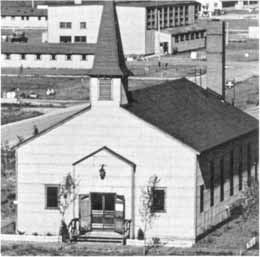
Kearney had a contingent of Swedes, but not at all the concentrations found to the south around Axtell and Holdrege. Still, there were Swedish Lutheran and Mission congregations to be found there but at first they had a hard time surviving. Today the Lutheran church with Augustana roots is very large and its grounds occupy what appears to be a whole block. In the early part of the century they struggled along with financial help from the conference. Historian Charles Sandahl represented the conference at the time and suggested that they relocate from their site south of the railroad tracks to the north side.
It is interesting that they could have sold their building then to a group of Syrian Orthodox Christians who formed another immigrant enclave in that neighborhood. That group continues to this day, and Saint George Antiochian Orthodox Church remains very much a presence there. But Sandahl's suggestion was rejected in a way that bears quotation: "Never before or since has he (Sandahl writes of himself) in such plain terms been told of his personal incompetency, as well as that of the conference, to handle church affairs." In retrospect, it was just that move north that proved the key to success.
More can be seen at www.Dalakarl.com under Immigrant Churches, Holdrege area.
-Dalakarl
................................................................
Setterdahls
But there was another couple that took on a similar challenge; that of visiting as many people and churches of the immigrant generation as possible in order to record their stories and written records for publication and preservation at Augustana College, Rock Island, Illinois. They were Lennart and Lillie Setterdahl. I treasure an email I received from Lillie in response to my thanking her for her book, Swedes in Moline, Illinois 1847-2002, when she speculated that she may have met relatives of mine when visiting Wausa. That would have been unlikely since the Greenwalls were Missions and the Setterdahls Lutherans. I may have been too hasty in that judgement as the following will show.
The jacket of the book mentioned above reports: "Her previous subjects include Scandinavians in Alabama, Rockford Swedes (co-authored), and Minnesota Swedes (two volumes). Moline Swedes is her eleventh publication on the subject of Swedes in America." She survived her husband by some years and continued to write extensively.
Roger Burke happened to mention that a man with a strong Swedish accent had visited the Stromsburg Baptist church when he was serving there, and prevailed upon him to microfilm the old church records. When asked if he were from Sweden, the man replied "I'm from Moline, Illinois." The circumstances made me suspect this visitor was none other than Lennart Setterdahl on one of his fact-finding missions.
Later, when showing a picture of Lennart to Roger it was confirmed that this indeed was the Moline visitor! The Setterdahls were interested in all Swedish immigrant churches. The records at Rock Island are probably the most complete of any archive thanks to them and other historians. We can only hope and pray that future scholars will study and publish stories based on the research these archives contain. They laid the foundation and told many of the stories, but many more remain untold. This is the debt we owe to the Setterdahls, and they came even to Stromsburg.
-Dalakarl
............................................................
Airport memories
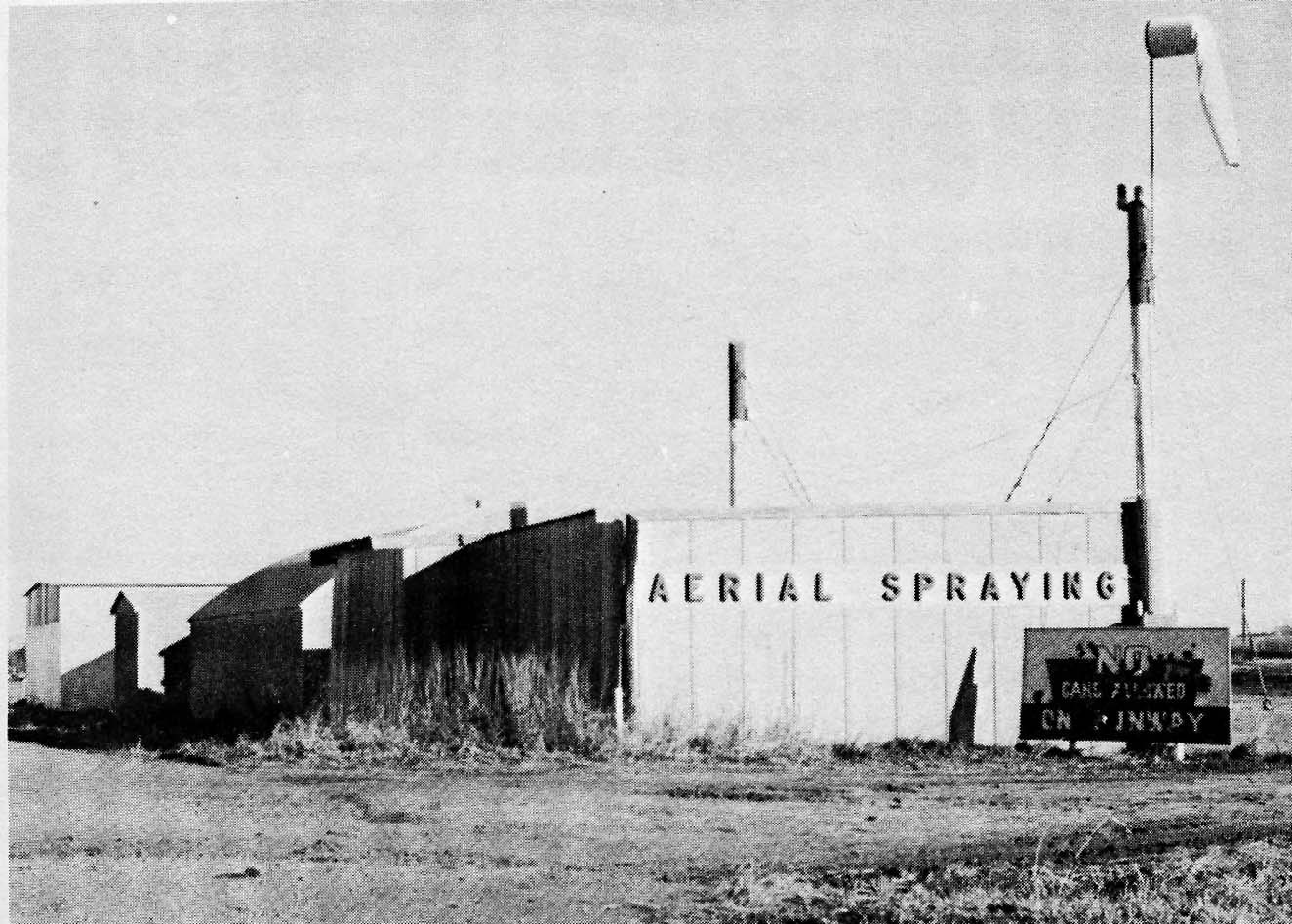
From about 1976 to 1979 we were regularly at the airport. Durward was operating his crop-spraying business and I was constructing my homebuilt airplane. He was particularly attentive to my son, John, and would let him sit in the Flying Club airplane and operate the rotating beacon. I'm sure John has never forgotten that.
Being a trained aircraft mechanic, Durward took great interest in my project and studied it in great detail. When he retired from his business I became the owner of the hangar he had used, and along with it a tray full of aircraft hardware that he no longer needed.
I still have that tray of miscellaneous hardware, and still sort through it regularly for nuts, bolts, washers or many other things that might be needed for a household project. I always think of Durward when doing it, and now it takes on even greater meaning. Standing by the graveside we could look across the tracks at the place where we spent so much time. "Precious memories, How they linger."
-Dalakarl
...............................................................
The famous Jenny Lind
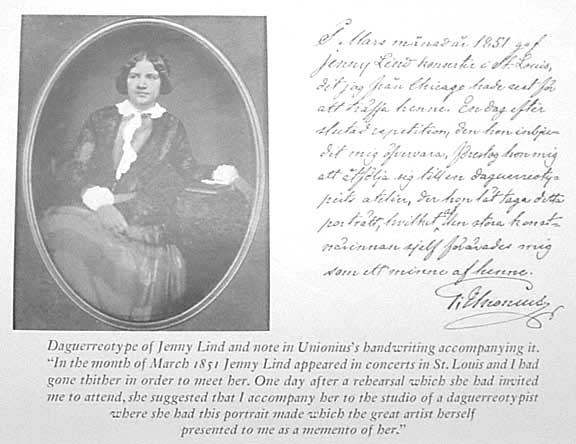
How curious that in a number of farm sales listed in Polk county in the 1920's and 30's there would be listed "a Jenny Lind walking two-row cultivator." How did the opera singer's name come to be associated with a farm implement? A little internet research revealed that other items also bore her name; quite common were "Jenny Lind" beds and quite a number of other consumer items.
With some justification one could speculate that these many endorsements which lent her name to unrelated products were the work of her American tour sponsor, P. T. Barnum. Yes, the circus entrepreneur was part of the Jenny Lind picture. Eleanor's father, now 96, remembers when his father manned the new two-row cultivator behind a four horse hitch while he and his brother were limited to the old one-row models and two horses. By his recollection it was not a Jenny Lind however.
Perhaps the most interesting appearance of her name can be found on the Arkansas map, just east and south of Fort Smith, near the Fort Chafee Army base (yes, that is where Elvis joined the Army). There are the twin towns, probably Scandinavian mining camps, called "Old Jenny Lind" and "New Jenny Lind." There must be a story there, but that's all I know.
Never underestimate the reach of internet search engines. There you can learn, among other things, that the Jenny Lind cultivators were produced by the Patee Implement company of Illinois, and that there are three of them on display at the Stuhr Museum in Grand Island! Wonder how one would look on the front lawn?
-Dalakarl
.............................................................
Barber shops
She said that her grandfather was Dan Evins, a barber. She had pictures of him at his barber chair, along with two others in the barber shop beneath what was then First National Bank. She had another picture of him standing beside a barber pole which stood on the sidewalk at that corner. Their home, she believed, was east of the school on 4th Street on what now is a vacant lot.
But she was clearly thrilled when the present occupants of the First National site, the publishers of this newspaper, took her down to where the barber shop had been and she was able to see evidence such as an abandoned barber chair and cabinet. Unfortunately, none of us thought to make copies of those pictures mentioned above and so we have to hope for another opportunity to do so. We also directed her to the lobby of Rose Colored Glass, where one of the mirrors featuring ads from local businesses of the era that graced the walls of the old barber shop are currently on display.
A nearly identical basement barber shop was to be found beneath a bank in Wausa, my home town. There one could obtain a 25 cent haircut seated on a board placed across the armrests of the barber chair. The aroma of those hair tonics and shaving lotions was unforgettable. It was a "men only" place, with hunting and sports magazines on the waiting bench.
Since learning of this barber, several friends have recalled being trimmed by him years ago and when his name appears in the old papers, it now has special meaning. Thanks to the lady who stopped by at the library.
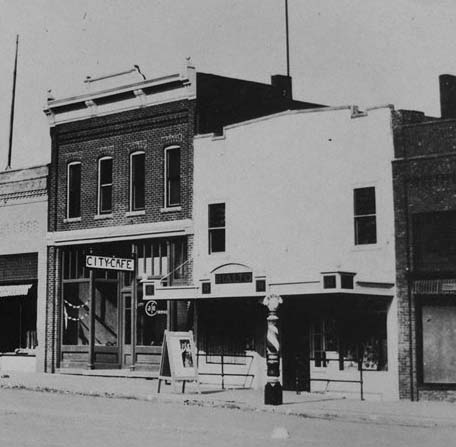
Another barber pole, beneath the Rialto, east side
-Dalakarl
......................................................
"It's a small world after all"
Some think of Stromsburg or Wausa, my hometown, as very small places, but there were many settlements even smaller where the Mission churches could not gain critical mass and were disbanded. I have a special interest in these places and even visited some. Belvidere, Verona or Lyons come to mind. In Lyons a Mission pastor named Oscar Beck organized a congregation and built a church just over a hundred years ago which was intended to be interdenominational. That building still stands but is now used by the school system for storage as I recall.
So, when the gentleman said he was from Lyons, I could reply that I knew exactly where that was and that I had visited there. Lyons is the first town north of Oakland. Then it occurred to me that someone I knew more recently had grown up in Lyons: Festival Queen Kathy Cowan to be exact. When I mentioned her name, the man replied: "Oh yes, I graduated from high school with her!" Such is the way with small towns.
But it was not entirely coincidental that these two Lyons people should be at the Festival. When Kathy learned of her impending honor she had the opportunity to contact family and friends to attend the parade and other events. Though these visitors had planned to come anyway, they adjusted their schedules to suit. You will have to ask Kathy his name, all I can recall is that it rhymed with "Black and Decker."
-Dalakarl
.........................................................
Augustana's early days
One such treasure came to us during the recent Swedish Festival in the form of a book, "The Augustana Synod 1860-1910." 1910 marked the 50th anniversary of the founding of that Synod. It was intended that a suitable book be written and published in both the English and Swedish languages for that occasion, but that could not be accomplished. Instead a series of articles by a variety of contributors was assembled and published, in English. In 1910 the immigrant Swedish churches were using Swedish exclusively and it must be said that some of the English appearing in this book reads in a stilted and awkward fashion. But its contents are extremely fascinating.
Rev. C.J. Petri writes of the pioneering days of the Synod, and his observations deserve quotation:
"The spiritual awakening in Sweden during the years 1840-1860 had filled the people with an earnest desire to honor God and to promote the extension of the kingdom of heaven. The Augustana Synod is a child of the spiritual revival in Sweden during these years."
"Among the early settlers many Christian laymen conducted...services, and it may truly and truthfully be said that the Augustana Synod was from the beginning a Laymen's Missionary Movement."
These comments reflect a very early perspective in the Augustana Synod history; one that I must say does not appear in later accounts. No doubt some bitter experiences caused a tightening of the reins in Rock Island and a distancing of Synod practices from its earliest character. I point this out to emphasize how very similar each of the immigrant denominations were in their formative days. These two quotations would not be out of place in the histories of the Swedish Methodists, Swedish Baptists, Mission Covenant or Free Mission traditions.
Thanks to Pastor Andy and the Sandsteds for preserving these insights.
-Dalakarl
...............................................
Free Festival Tour
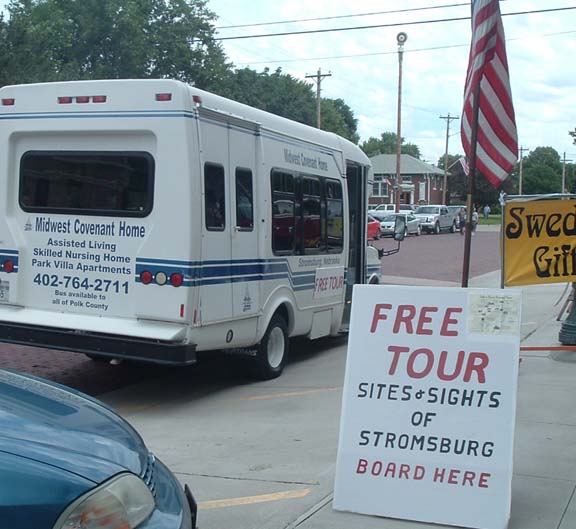
Once again I donned my "student mösse" (cap) for the occasion though no one asked, as did a little girl last time, "are you a real captain?" That's my gesture in the direction of a Swedish costume: students in Swedish universities wore them with identifying insignia. Pictures of the early days at North Park College in Chicago show that this custom was observed there as well. No one enjoys these tours more than I.
Additional points of interest along the route this year included the Old Library, the Methodist Campgrounds and the Arboretum. Special emphasis was placed on Covenant Home because of their role in providing the weatherproof and air conditioned conveyance.
There were too few riders on Friday, so future plans call for Saturday only runs. Three ladies were late for the Smorgåsbord and requested an abbreviated tour en route. Why not? Jump right in! Following the program at the new library, an impromptu group began their tour from that location. Yes, it was a learning experience.
The purpose of the brochure mentioned above is to provide a way for visitors to take their own self-guided tours: a walk around the square and a drive around the town. That way it can happen any time and for anyone.
-Dalakarl
...................................................
McCunes' Winton Car

Seeing something like this throws light on the subject of the McCunes and their stately touring car (larger and more elegant than a lowly Model T) which makes me wish I had paid more attention to them while reading the Headlights from that era. A quick look at the local history books reminds us that McCune's daughter was married to Wesley Wilson, and that McCune himself was a partner with the Wilsons in developing the towns of Polk and Hordville.
What appears to be the same car is featured in the photo series of the 1906 "Round the World" tour found online by Charles Noyd. In that picture McCune is not grinning behind the wheel as we might expect today, but rather is reigning from the back seat in dignified hat and whiskers. Up front is son-in-law Wilson with young son Jim, according to people who should know. Stay tuned for more about the car and the McCunes as information becomes available.
Meantime, the trip to Colorado is underway. The touring car is the main attraction, seen ascending mountain roads that are literally "rocky", crossing rushing streams on rickety wooden bridges, and on lofty mountaintops. Donkey rides up Pikes Peak and tunnels along the roadway are among the memorable images captured in the album. The skillful photographer who took these pictures also included some local shots. There is a series of the car hopelessly mired in a muddy road, first being helped along by some sort of leverage device, and finally succombing to the humiliation of being pulled out by a team of horses.
The reality is that horses are on the way out, and even the railroads will not be able to compete with the auto as the favored means of transportation for residents of Polk county, and America. As a footnote, one of the pictures in the album is of the Victor Anderson building with the huge "Come to Church" illuminated sign on the roof. That would date the album to 1917.
-Dalakarl
.....................................................
A House of Steel
Somewhere along the line a newspaper article revealed that these were manufactured after world war two by a company that later went bankrupt, much like the Tucker automobile company. Then, more recently, when driving through Osceola on the street which goes by the fairgrounds toward downtown I spotted one of these very houses on the east side of the street! Thanks to the internet, my newly aroused curiousity could be satisfied:
In an effort to ease the transition from a wartime economy to peacetime, the government devised a "reconstruction finance" organization to regear armament plants for consumer products. A gentleman named Carl Stranlund, a name sounding suspiciously Swedish, launched a plan to utilize a former warplane factory to turn out all-metal, prefabricated housing called "Lustron Homes." By today's standards they were small, but quite affordable and even more so if the factor of mass production could be achieved.
The most noticeable thing about Lustron Homes was the siding; metal squares stamped out by the thousands and spray painted at the factory like auto parts. Just why Stranlund's plan went awry is lost in the mystery of big corporations and high finance, but like the Tucker situation, there are conspiracy theories that suggest the housing industry moguls sabotaged the whole thing.
There were Lustrons scattered about Chicago, always noticeable at a glance, and now imagine finding one in Osceola! That one has a cute Lustron single car garage as well. One thing is for certain; after fifty plus years they have proven to be durable!
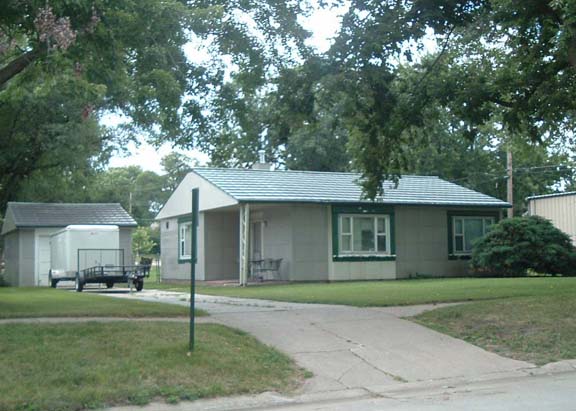
-Dalakarl
......................................................
Spinning Wheels
One of the articles was about a lady in Wyoming who was turning unmarketable black wool into sweaters and shawls for sheep raisers. She had an ambitious plan to organize spinners around the state and already had 300 members. Mohair from goats, llama hair, and rabbit angora fibers all could be spun on a spinning wheel. This lady's name was Upton, and I gather she was descended from Gustaf Adolph and Alma (Nyblom) Johnson of Swede Home.
Her aunt was Nannie Sundberg, according to the obituary supplied, and that name recalls another spinning wheel story, one in which Jennie Sundberg demonstrated to Eleanor and I how to operate the spinning wheel she owned. That one, we are told, had been purchased by Ruth Sundberg. The Upton spinning wheel, or one example of the six she admitted to owning, is the one that our source is hoping will be preserved as an example of one of yesteryear's wonders.
Presently, though I know very little about it, my wife informs me that the best source of information about spinning would be Dr. John and Jean Esther Dale. They enthusiastically practice the craft and willingly share what they do with others, so my advice would be to look them up for more about the subject.
-Dalakarl
...................................................